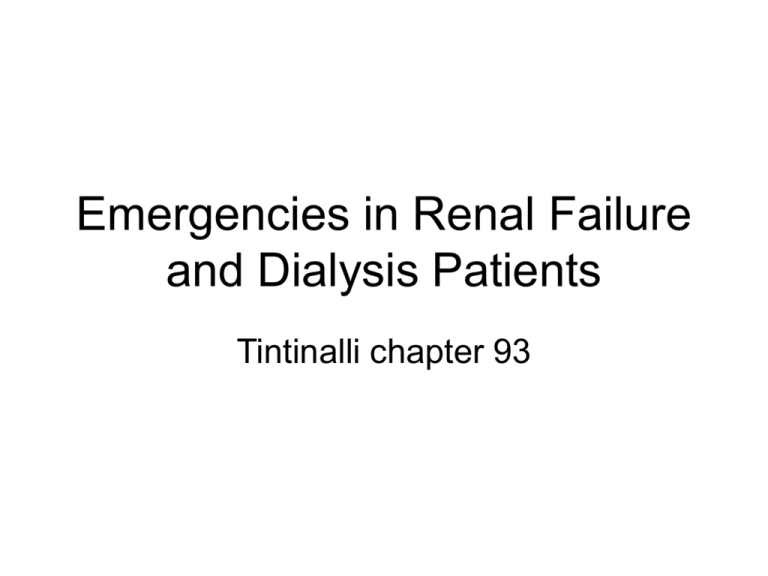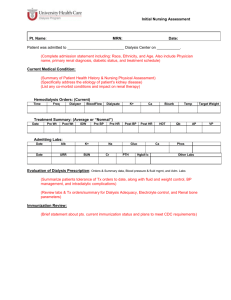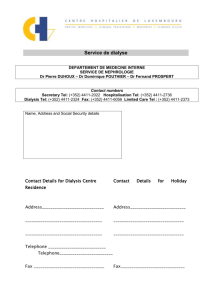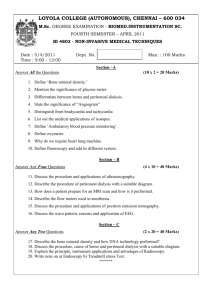Emergencies in Renal Failure and Dialysis Patients
advertisement

Emergencies in Renal Failure and Dialysis Patients Tintinalli chapter 93 • ESRD: irreversible loss of renal function, accumulation of toxins and loss of internal homeostasis. • Uremia: clinical syndrome resulting from ESRD. Epidemiology • 1999=89,252 new cases/424,179 patients being tx for ESRD • Causes: DM=#1, HTN=#2 • Therapy: dialysis=70% – transplants=30% • ESRD deaths: 50% cardiac causes. – 10-25% infectious • Survival rates for 1,2,5 yrs= 79, 65, 34 % respectively Pathophysiology of Uremia • Excretory Failure: causes >70 chemicals to elevate. Urea= major breakdown of proteins. Limit protein intake • Biosynthetic Failure: loss of hormones 1,25(OH)3 vit D3 and erythropoietin. – 85% of erythropoietin produced by kidney. – Vit. D3 deficiency= secondary hyperparathyroidism, renal bone disease. Pathophysiology of Uremia • Regulatory Failure: over secretion of hormones , disruption of normal feedback mechanisms Clinical Features of Uremia • Neurologic complications: • Subdural hematoma: 3.5% of ESRD, HTN, head trauma, bleeding dyscrasias, anticoagulants, ultrafiltration. • Uremic Encephalopathy: nonspecific centreal neurologic symptoms, responds to dialysis. • Neurologic complications: • Dialysis Dementia: like uremic encephalopathy but progressive and fatal, seen after 2 years on dialysis • Peripheral neuropathy: >50% of HD patients. “glove and stocking pattern”, improves after transplant • Autonomic dysfunction: common; dizzy, impotence, bowel dysfunction. • Cardiovascular complications: prevalence is greater in ESRD • d/t pre-existing conditions, uremia, toxins, high lipids, homocystine, hyperparathyroidism, dialysis related conditions • • • • General population CAD: 12% LV hypert. 20% CHF 5% • • • • ESRD 40% 75% 40% • Creatine protein Kinase &MB, Troponin I and T…….NOT significantly elevated in patients undergoing regular dialysis, have been shown to be specific markers in these patients. • HTN: 80-90% of ESRD starting dialysis. d/t volume, vasopressor effects of kidney, RAS system. Tx initially w/ volume control • CHF: HTN #1 cause in ESRD. • Uremic cardiomyopathy: dx of exclusion when other causes of CHF ruled out. • Pulmonary Edema: fluid overload, MI. – Tx w/ O2, nitrates, ACE inhib, morphine, diuretics. Can also use phlebotomy, dialysis. • Cardiac Tamponade: rarely w/ classic presentation of low BP, muffled sounds and JVD. – Echocardiography, pericardiocentisis • Pericarditis/ Uremic Pericarditis: • Uremic more common=75% • Fluid overload, abnl platelet function, ↑ fibrinolytic and inflammatory cell activity • Friction Rubs= louder, palpable, persist after metabolic abnormality resolved • BUN always>60 mg/dl • Absent EKG changes • Dialysis related percarditis: recurrent, most common type during dialysis. More common adhesions and fluid loculations • ESRD w/ pericarditis= 8% • Tx w/ dialysis • Avg survival without dialysis= 1 month • Hematologic Complications: • Anemia: low erythropoietin, blood loss from dialysis, ↓ RBC survival times – Normocytic, normochromic – Hct stabilizes @ 15-20 without tx. – Tx=erythropoietin • Bleeding diathesis: ↑ risk of GI bleed, subdural. – Can try tx with desmopressin • Immunologic deficiency: leukocyte chemotaxis and phagocytosis decreased in uremic state. – Dialysis does not help immune function. • GI complications: • Anorexia, nausea, vomiting=common in uremia • Increased GI bleeding • Chronic constipation • Ascites from portal HTN, polycystic liver ds., fluid overload. • Renal Bone Disease: • Systemic calcification; ↓ GFR=↑ serum phosphate levels. – Pseudogout, metastatic calcification of tissues, vessels. – Tx=low Ca dialysate and phosphate-binding gels • Hyperparathyroidism (Osteitis Fibrosa Cystica); – ↓ ionized Ca=↑ PTH= high bone turnover, weak bones. – Tx=phosphate binding gels, Vit D3 replacement, subtotal parathyroidectomy • Osteomalacia; defect in bone calcification • d/t Vit.D3 deficiency and aluminum intoxication • Weakened bones, muscle pains, weakness • Low PTH, ow to normal alkaline phosphate levels, ↑ serum aluminum • Tx= desferrioxamine • • • • Β2-Microglobulin amyloidosis: Pts >50 yrs old, on dialysis >10 yrs Amyloid deposits in GI tract, bones, joints. Complications; GI perfs, bone fx’s, carpal tunnel, rotator cuff tears. • Pts w/ amyloidosis have ↑ mortality rates Hemodialysis • Uses ultrafiltration and clearance to replace nephron. • Solute removal depends on filter pore size and concentration gradient • Heparin 1000-2000 units typically used • Sessions take @ 3-4 hrs. Vascular Access Complications • Types of Access: • 1. A-V fistula • 2. Vascular graft: higher complication rates, shorter functional lifes. • 3. Tunnel-cuffed catheters; Hickman, Quinton • • • • Thrombosis and Stenosis of Access: Most common complication Loss of bruit and thrill Stenosis / thrombosis: not Emergencies= tx w/in 24 hours. • Vascular Access Infections: • 2-5% of fistulas, 10% of grafts • Often signs of sepsis, fever, Hypotension, ↑ WBC • Erythema, swelling, discharge at site often missing. • Staph Aureus #1, gram neg #2 • Vanc is drug of choice, usually add Gent. • Hemorrhage: • d/t aneurysm, anastomosis rupture or over anticoagulation. • Direct pressure • Protamine 10-20 mg or 0.01 mg/unit hep. • Consult surgery or nephrology • • • • • Vascular access aneurysms: Repeated punctures Bulging in wall Rarely rupture True aneurysms very rare; 4% of fistulas • Vascular access pseudoaneurysm: • Subcutaneous extravasation of blood • Present w/ bleeding & infection at site • Vascular insufficiency: distal to access • “steal syndrome” • Preferential shunting of blood to low pressure venous side • s/s exercise pain, non-healing ulcers, cool pulseless digits • Dx w/ doppler or angiography • High-output heart failure: • When 20% of cardiac output diverted through access • Branham sign: drop in HR after temporary access occlusion • Doppler to measure access flow rate • Surgical banding of access is Tx. Complications During Hemodialysis • • • • 1. Hypotension: Most frequent, 10-20% of treatments Dialysis can remove up to 2 L/hr. Cardiac compensation limited d/t ↓ diastolic function common in ESRD • Abnormalities in vascular tone; sepsis, anit HTN meds, ↑ nitric oxide • Early hypotension: pre-existing hypovolemia • Peridialysis losses; starts HD below dry weight; d/t sepsis, GI bleed, vomiting, diarrhea, decreased salt/water intake • Intradialytic blood loss from tubing/dialyzer leads • Hypotension at end of dialysis: excessive removal, cardiac or pericardial disease. • Intradialytic hypotension: • N/V/anxiety, ortho hypotension, tachycardia, dizzy, syncope. • Tx.; stop HD, Trendelenburg. Salt, broth by mouth, NS 100-200 cc. IV. • If these fail look for other causes than excessive fluid removal • 2. Dialysis disequilibrium: • End of dialysis • N/V, HTN...progress to coma, seizure and death • d/t cerebral edema after large solute clearance in HD • Tx. Stop HD, administer Mannitol IV. • 3. Air Embolism: • s/s: dyspnea, chest tightness, unconscious, full cardiac arrest. Cyanosis, churning sound in heart from bubbles • Clamp venous blood line, place supine • Other Tx’s: percutaneous aspiration from R ventricle, IV steroids, full heparinization, hyperbaric O2 treatment • 4. Electrolyte abnormalities: • ↑ Ca, ↑Mg • N/V, HA, burning skin, weakness, lethargy HTN • 5. Hypoglycemia Evaluation of HD Patients • • • • Dialysis schedule Dry weight Length of dialysis Inspect access site; erythema, swelling, tender, discharge. • Peripheral edema, HJR, JVD not always CHF • Murmurs; high flow d/t anemia? Peritoneal Dialysis • Peritoneal membrane= blood-dialysate interface • Can be done acutely, chronically(continuous)=4 times/day, or multiple exchanges at night while sleeping. Complications • • • • Peritonitis #1 Mortality 2.5-12.5 % Fever, abd pain, rebound tender Dialysate fluid for cell count, Gram stain, culture • Staph epidermidis 40%, S. aureus 10%, Strep species 15-20%, gram neg bacteria 15-20%, anaerobic bacteria 5%, fungi 5%. • • • • Empiric antibiotic therapy Add to dialysate Parenteral administration not needed Rapid exchanges of fluid lavage to wash out inflammatory cells • First gen Ceph • Vanc if pen allergic • Can add Gent • • • • • Infections around PD catheter site: Pain, erythema, swelling, discharge. S. aureus, Pseudomonas aeruginosa Empiric w/ first generation Ceph or Cipro Outpatient therapy with f/u at CAPD center next day • • • • Abdominal wall hernia 10-15% Highest rate of incarcerating Immediate surgical repair Overview Evaluating PD Patient • • • • • Type and frequency of dialysis Date of last episode of peritonitis Frequency of relapse infections Baseline weight Focus on abdomen and catheter tunnel Questions: • 1. T/F Peripheral Neuropathy, “stocking and glove pattern”, is rarely seen in ESRD pts on dialysis. • 2. T/F ESRD patients carry the same cardiovascular risk as general population. • 3. T/F Troponins are commonly significantly elevated in patients on regular dialysis and cannot be trusted as cardiac marker. • 4. #1 cause of dialysis access site infections… – A. klebsiella – B. staph aureus – C. strep species – D. E. coli • 5. #1 complication during dialysis sessions is …. – A. hypotension – B. fever – C. CHF – D. cough Answers: false (seen in 50%), false(inc risk), false, B, A.





